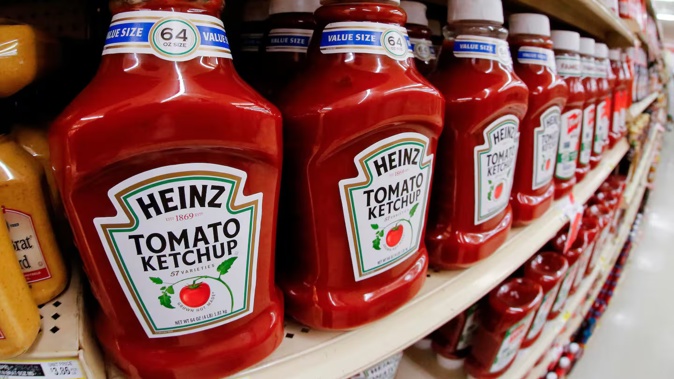
American multinational Kraft Heinz – the maker of ketchup, macaroni and cheese and other pantry standbys – has announced it will split up a decade after its merger created one of the largest food companies in the world.
One company will focus on sauces, spreads and seasonings, and retain brands such as Heinz Ketchup, Philadelphia cream cheese and Kraft Mac & Cheese. The other will include Oscar Mayer, Kraft Singles cheese and Lunchables, and will be led by current Kraft Heinz chief executive Carlos Abrams-Rivera, the company said.
The announcement comes as shoppers have become more price-conscious about their food choices; they’re spending less on eating out and increasingly turning to private-label brands in store aisles amid inflation and broader economic uncertainty.
They’re also leaning into less processed options. Kraft Heinz’s signature Lunchables – prepackaged trays of deli meat, cheese, crackers and other offerings geared at children – were removed from school lunch trays last year because of a lack of demand. Plus, the rising use of weight-loss drugs such as Ozempic and Wegovy has cut into sales for snack foods and sugary drinks.
The company has acknowledged those shifts, releasing Capri Sun juice pouches with less sugar and hot dogs without added nitrates or artificial preservatives. Kraft Heinz also said it would remove artificial colours from United States products before the end of 2027, in line with the Trump administration’s push to have food companies phase out synthetic dyes.
Kraft Heinz shares tumbled nearly 7% on Wednesday (Tuesday US time), closing at US$26.02. The stock is down more than 20% in the past year – decreasing more than food-related market indexes – and has shed more than 60% since the merger went through in July 2015. By comparison, the S&P 500 index is up 16% year over year and has more than tripled in the past decade.
“They thought one plus one might equal three, and it kind of equalled a little less than two,” said Hank Cardello, an executive-in-residence at Georgetown University’s Business for Impact centre.
Kraft Heinz in May said it was looking into potential transactions.
“By separating into two companies, we can allocate the right level of attention and resources to unlock the potential of each brand to drive better performance and the creation of long-term shareholder value,” said Miguel Patricio, executive chair of Kraft Heinz’s board.
The rationale is a reversal of their motivation to combine in the first place, an effort to revive Kraft’s and Heinz’s fortunes in the face of changing American habits. The roughly US$45 billion ($76.8b) deal was orchestrated by Warren Buffett’s Berkshire Hathaway and Brazilian private-equity firm 3G Capital. Buffett told CNBC on Tuesday that he was “disappointed” in the news, the television channel said.
Several other food and beverage giants have broken up in recent years. Last month, Keurig Dr Pepper announced it would acquire the owner of Peet’s Coffee and then split in two, less than a decade after merging. Cereal maker Kellogg’s divided into WK Kellogg Co and Kellanova in 2023.
With “the mega-portfolios that have been around in the food industry for years, it’s tough to convince your shareholders or your stakeholders that you have significant growth because you have other brands that are slowing down”, said Russell Zwanka, a food marketing professor at Western Michigan University.
The split announcement on Wednesday will spin off high-growth brands including Philadelphia cream cheese and Kraft Mac & Cheese from more stable offerings such as Maxwell House and Capri Sun, Zwanka said. The new Kraft Heinz company focused on condiments had about US$15.4b in net sales last year; the other generated about US$10.4b, the company said.
“They’ll still be good brands. But sometimes brands are on their way up and high-trend, and sometimes brands are just stable … and it’s easier to run a company and allocate resources if you split it that way,” Zwanka said.
Big companies are seeing an opportunity to “think small” – downsizing to increase flexibility and direct capital to top products – as they cater to new consumer preferences driven by Gen Z and millennials, said Stephen Zagor, a Columbia Business School professor focused on food and restaurants.
Some major brands are also under pressure from generic store offerings that lost market share during the pandemic, said Charlotte Ambrozek, an assistant professor of applied economics at the University of Minnesota with expertise in food retail and consumer economics. That boost for big brands, now reversing, came as consumers cut back on dining out and as some private-label suppliers battled pandemic-era supply chain kinks that were better weathered by large brands, Ambrozek said.
Cardello, a former executive at Coca-Cola USA and other food and beverage companies, said Kraft Heinz needs to develop new products and features – such as portion-controlled offerings for GLP-1 users or snacks for young consumers who prefer grazing to eating square meals.
Without changes, the two new companies could be vulnerable to an undesirable acquisition, he said.
The separation is expected to close in the second half of 2026.
Take your Radio, Podcasts and Music with you









